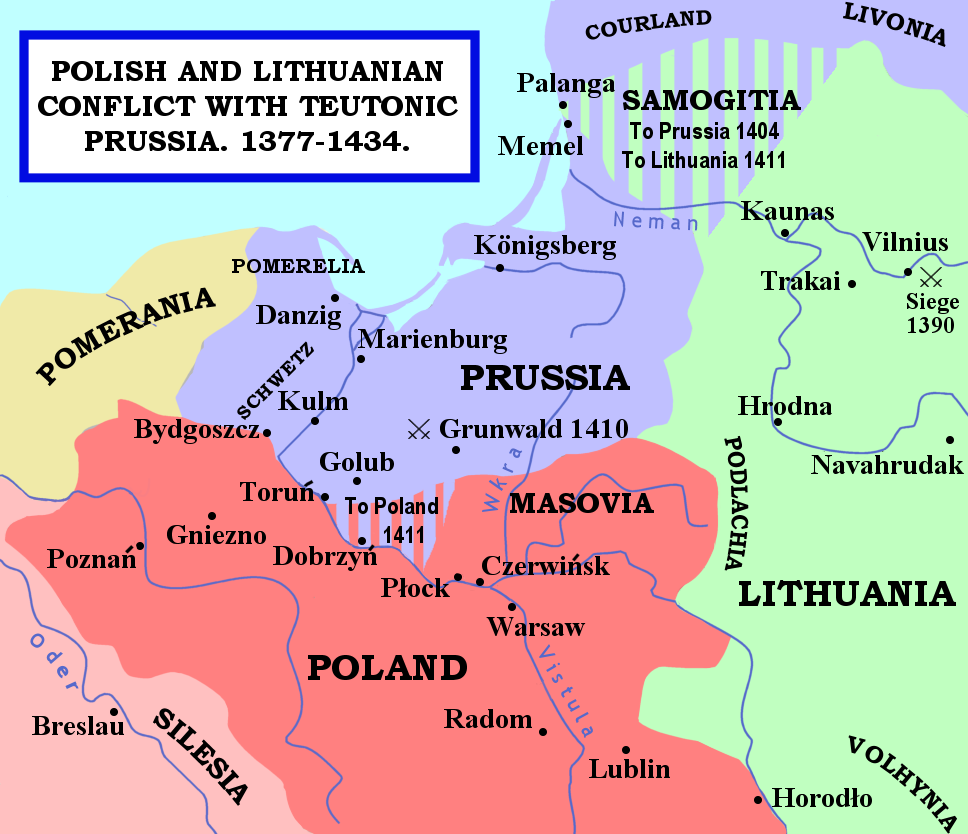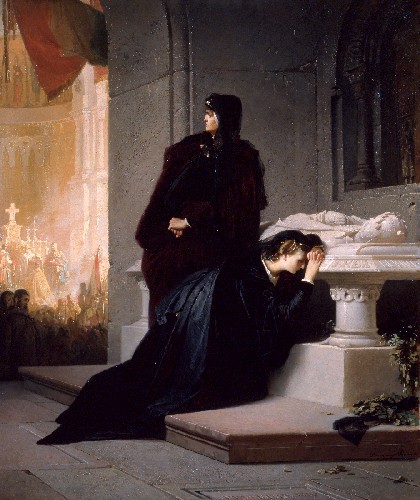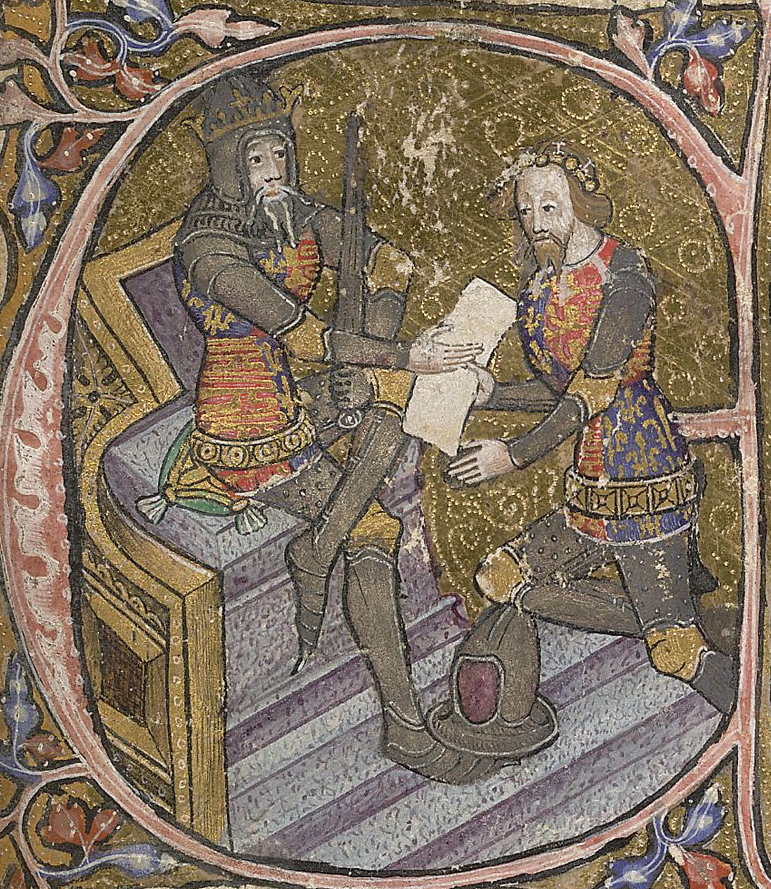|
1386
Year 1386 ( MCCCLXXXVI) was a common year starting on Monday of the Julian calendar. Events January–December * February 24 – Elizabeth of Bosnia, the mother of the overthrown Queen Mary of Hungary and Croatia, arranges the assassination of Charles III of Naples, the ruler of Hungary, Naples, Achaea and Croatia, with the result that: ** Mary is reinstated as Queen of Hungary and Croatia. ** Charles' son, Ladislaus, becomes King of Naples. ** A period of interregnum begins in Achaea, lasting until 1396. The rule of Achaea is sought by numerous pretenders, none of whom can be considered to have reigned. * March 4 – Grand Duke of Lithuania Jogaila (having been baptised on February 15 in Wawel Cathedral, Kraków, and on February 18 married Jadwiga, 12-year-old queen regnant of Poland) is crowned Władysław II Jagiełło, King of Poland, beginning the Jagiellonian dynasty. * May 9 – King John I of Portugal and King Richard II of England ratif ... [...More Info...] [...Related Items...] OR: [Wikipedia] [Google] [Baidu] |
Władysław II Jagiełło
Jogaila (; 1 June 1434), later Władysław II Jagiełło (),Other names include (; ) (see also Names and titles of Władysław II Jagiełło) was Grand Duke of Lithuania beginning in 1377 and starting in 1386, becoming King of Poland as well. As Grand Duke, he ruled Lithuania from 1377 to 1381 and from 1382 to 1401, at which time he became the Supreme Duke of Lithuania in exchange for naming his cousin Vytautas as the new Grand Duke. Władysław II initially served as King of Poland alongside his wife Jadwiga of Poland, Jadwiga until her death in 1399, and then the sole ruler until his own death in 1434. Raised a Lithuanian polytheist, he converted to Catholicism in 1386 and baptized as Ladislaus () in Kraków, married the young Queen Jadwiga, and was crowned King of Poland as Władysław II Jagiełło. In 1387, he Christianization of Lithuania, converted Lithuania to Catholicism. His reign in Poland started in 1399, upon the death of Queen Jadwiga, lasted a further thirty-fiv ... [...More Info...] [...Related Items...] OR: [Wikipedia] [Google] [Baidu] |
Charles III Of Naples
Charles of Durazzo, also called Charles the Small (1345 – 24 February 1386), was King of Naples and the titular King of Jerusalem from 1382 to 1386 as Charles III, and King of Hungary from 1385 to 1386 as Charles II. In 1381, Charles created the chivalric Order of the Ship. In 1383, he succeeded to the Principality of Achaea on the death of James of Baux. Life Childhood and youth (1354/1357 – 1370) He was the only child of Louis of Durazzo and his wife, Margaret of Sanseverino. Louis of Durazzo was a younger son of John, Duke of Durazzo, the youngest son of King Charles II of Naples and Mary of Hungary. Charles's date of birth is uncertain: he was born in 1354, according to historian Szilárd Süttő, and in 1357, according to Nancy Goldstone. Charles was born in Durazzo. Louis of Durazzo rebelled against his cousins, Joanna I of Naples, and her husband, Louis of Taranto in the spring of 1360, but he was defeated. He was also compelled to send the child Charles ... [...More Info...] [...Related Items...] OR: [Wikipedia] [Google] [Baidu] |
Jadwiga Of Poland
Jadwiga (; 1373 or 137417 July 1399), also known as Hedwig (from German) and in , was the first woman to be crowned as monarch of the Kingdom of Poland. She reigned from 16 October 1384 until her death. Born in Buda, she was the youngest daughter of Louis I of Hungary and Poland, and his wife, Elizabeth of Bosnia. Jadwiga was a member of the Capetian House of Anjou, but she had more close forebears among the Polish Piasts than among the mostly French Angevins. In 1375, it was planned that when becoming old enough, Jadwiga would marry William of Austria and she lived in Vienna from 1378 to 1380. Louis I is often thought to have regarded her and William as his favoured successors in Hungary after the 1378 death of her eldest sister, Catherine of Hungary (1370–1378), Catherine, since the following year the Polish nobility had pledged their homage to Louis' second daughter, Mary, Queen of Hungary, Mary, and Mary's fiancé, Sigismund of Luxembourg. However, Louis died, and in 138 ... [...More Info...] [...Related Items...] OR: [Wikipedia] [Google] [Baidu] |
Mary Of Hungary
Mary, also known as Maria of Anjou (, , ; 137117 May 1395), queen regnant, reigned as Queen of Hungary and List of dukes and kings of Croatia, Croatia between 1382 and 1385, and from 1386 until her death. She was the daughter of Louis I of Hungary, Louis the Great, King of Hungary and King of Poland, Poland, and his wife, Elizabeth of Bosnia. Mary's marriage to Sigismund of Luxembourg, a member of the imperial Luxembourg dynasty, was already decided before her first birthday. A delegation of Polish prelates and lords confirmed her right to succeed her father in Poland in 1379. Having no male siblings, Mary was crowned "king" of Hungary on 17September 1382, seven days after Louis the Great's death. Her mother, who had assumed the regent, regency, absolved the Polish noblemen from their oath of loyalty to Mary in favour of Mary's younger sister, Jadwiga of Poland, Jadwiga, in early 1383. The idea of a female monarch remained unpopular among the Hungarian noblemen, the majority of ... [...More Info...] [...Related Items...] OR: [Wikipedia] [Google] [Baidu] |
Treaty Of Windsor (1386)
The Treaty of Windsor is a diplomatic alliance signed between the Kingdom of Portugal and the Kingdom of England on 24 February 1387 in Windsor, Berkshire, and sealed by the marriage of King John I of Portugal (House of Aviz) to Philippa of Lancaster, daughter of John of Gaunt, 1st Duke of Lancaster. With the victory at the Battle of Aljubarrota, assisted by English archers, John I was recognised as the undisputed King of Portugal, putting an end to the ''interregnum'' of the 1383–1385 Crisis. The Treaty of Windsor established a pact of mutual support. Copies are preserved at the Torre do Tombo National Archive in Lisbon and The National Archives in London. The historian Matthew Winslett says, "This treaty has been the cornerstone of both nations' relations with each other ever since." Still in effect today, it is the longest-lasting diplomatic treaty in recorded history.''BBC History Revealed'' magazine; May 2023 issue; p. 15 See also *Anglo-Portuguese Treaty of 1373 * * ... [...More Info...] [...Related Items...] OR: [Wikipedia] [Google] [Baidu] |
Battle Of Sempach
The Battle of Sempach was fought on 9 July 1386, between Leopold III, Duke of Austria and the Old Swiss Confederacy. The battle was a decisive Swiss victory in which Duke Leopold and numerous Austrian nobles died. The victory helped turn the loosely allied Swiss Confederation into a more unified nation and is seen as a turning point in the growth of Switzerland. Background During 1383 and 1384, the expansion of the Old Swiss Confederacy collided with Austrian interests. The interests of Austria were further undermined in the Pact of Constance, a union of Zürich, Zug, Solothurn and 51 cities of Swabia. In 1385, there were various attacks, without formal declaration of war or central organization, by forces of Zürich, Zug and Lucerne on the Austrian strongholds of Rapperswil, Rothenburg, Switzerland, Rothenburg, St. Andreas Castle, Cham and Wolhusen. In 1384 the people of Entlebuch receive the Lucerne citizenry and on Epiphany (holiday), Epiphany, on 6 January 1386, Lucerne exp ... [...More Info...] [...Related Items...] OR: [Wikipedia] [Google] [Baidu] |
Jagiellonian Dynasty
The Jagiellonian ( ) or Jagellonian dynasty ( ; ; ), otherwise the Jagiellon dynasty (), the House of Jagiellon (), or simply the Jagiellons (; ; ), was the name assumed by a cadet branch of the Lithuanian ducal dynasty of Gediminids upon reception by Jogaila, the Grand Duke of Lithuania, of baptism as Ladislaus in 1386, which paved the way to his ensuing marriage to the Queen Regnant Hedwig of Poland, resulting in his ascension to the Crown of the Kingdom of Poland as Ladislaus II Jagiełło (initially ruling ''jure uxoris'' jointly with Jadwiga until her death), and the effective promotion of his branch to a royal dynasty. The Jagiellons were polyglots and per historical evidence Casimir IV Jagiellon and his son Saint Casimir possibly were the last Jagiellons who spoke in their patrilineality, patrilineal ancestors' Lithuanian language; however, even the last patrilineal Jagiellonian monarch Sigismund II Augustus maintained two separate and equally lavish Lithuanian-speaking an ... [...More Info...] [...Related Items...] OR: [Wikipedia] [Google] [Baidu] |
Grand Duchy Of Lithuania
The Grand Duchy of Lithuania was a sovereign state in northeastern Europe that existed from the 13th century, succeeding the Kingdom of Lithuania, to the late 18th century, when the territory was suppressed during the 1795 Partitions of Poland, partitions of Poland–Lithuania. The state was founded by Lithuanians (tribe), Lithuanians, who were at the time a Lithuanian mythology, polytheistic nation of several united Baltic tribes from Aukštaitija. By 1440 the grand duchy had become the largest European state, controlling an area from the Baltic Sea in the north to the Black Sea in the south. The grand duchy expanded to include large portions of the former Kievan Rus' and other neighbouring states, including what is now Belarus, Lithuania, most of Ukraine as well as parts of Latvia, Moldova, Poland and Russia. At its greatest extent, in the 15th century, it was the largest state in Europe. It was a multinational state, multi-ethnic and multiconfessionalism, multiconfessional sta ... [...More Info...] [...Related Items...] OR: [Wikipedia] [Google] [Baidu] |
Elizabeth Of Bosnia
Elizabeth of Bosnia ( sh-Latn-Cyrl, separator=/, Elizabeta Kotromanić, Јелисавета Котроманић ; ; ; – January 1387) was queen consort of Kingdom of Hungary, Hungary and Croatia in personal union with Hungary, Croatia, and queen consort of Kingdom of Poland (1025–1385), Poland, and, after becoming widowed, the regent of Hungary and Croatia between 1382 and 1385 and in 1386. Daughter of Stephen II, Ban of Bosnia, Ban Stephen II of Banate of Bosnia, Bosnia, Elizabeth became List of Hungarian consorts, Queen of Hungary upon marrying Louis I of Hungary, King Louis I the Great in 1353. In 1370, she gave birth to a long-anticipated heir, Catherine of Hungary (1370–1378), Catherine, and became List of Polish consorts, Queen of Poland when Louis ascended the Polish throne. The royal couple had two more daughters, Mary, Queen of Hungary, Mary and Jadwiga of Poland, Hedwig, but Catherine died in 1378. Initially a consort with no substantial influ ... [...More Info...] [...Related Items...] OR: [Wikipedia] [Google] [Baidu] |
Ladislaus Of Naples
Ladislaus the Magnanimous (, ; 15 February 1377 – 6 August 1414) was King of Naples from 1386 until his death and an unsuccessful claimant to the kingdoms of Hungary and Croatia. Ladislaus was a skilled political and military leader, protector and controller of Pope Innocent VII; however, he earned a bad reputation concerning his personal life. He profited from disorder throughout Italy to greatly expand his kingdom and his power, appropriating much of the Papal States to his own use. He was the last male of the Capetian House of Anjou. Youth Ladislaus was born in Naples on 15 February 1377 during the reign of his great-aunt Queen Joanna I of Naples. He was the son of Charles and Margaret of Durazzo, both members of the Capetian House of Anjou. His parents, having lived for years at the court of their kinsman King Louis I of Hungary, named him after King Saint Ladislaus I of Hungary. In 1379 his father declared war on Joanna and proclaimed himself king with the backing of Pope ... [...More Info...] [...Related Items...] OR: [Wikipedia] [Google] [Baidu] |
Richard II Of England
Richard II (6 January 1367 – ), also known as Richard of Bordeaux, was King of England from 1377 until he was deposed in 1399. He was the son of Edward the Black Prince, Edward, Prince of Wales (later known as the Black Prince), and Joan, Countess of Kent. Richard's father died in 1376, leaving Richard as List of heirs to the English throne, heir apparent to his grandfather, King Edward III; upon the latter's death, the 10-year-old Richard succeeded to the throne. During Richard's first years as king, government was in the hands of a series of regency councils, influenced by Richard's uncles John of Gaunt and Thomas of Woodstock. England at that time faced various problems, most notably the Hundred Years' War. A major challenge of the reign was the Peasants' Revolt in 1381, and the young king played a central part in the successful suppression of this crisis. Less warlike than either his father or grandfather, he sought to bring an end to the Hundred Years' War. A firm ... [...More Info...] [...Related Items...] OR: [Wikipedia] [Google] [Baidu] |
King Of Poland
Poland was ruled at various times either by dukes and princes (10th to 14th centuries) or by kings (11th to 18th centuries). During the latter period, a tradition of Royal elections in Poland, free election of monarchs made it a uniquely electable position in Europe (16th to 18th centuries). The first Polish ruler whose existence is not debatable was Mieszko I, Duke Mieszko I, who Christianization of Poland, adopted Christianity under the authority of Rome in the year 966. He was succeeded by his son, Bolesław I the Brave, who greatly expanded the boundaries of the Polish state and ruled as the first king in 1025. The following centuries gave rise to the mighty Piast dynasty, consisting of both kings such as Mieszko II Lambert, Przemysł II or Władysław I the Elbow-high and dukes like Bolesław III Wrymouth. The dynasty's rule over Poland ceased with the death of Casimir III the Great in 1370. In the same year, the Capetian House of Anjou became the ruling house with Louis I t ... [...More Info...] [...Related Items...] OR: [Wikipedia] [Google] [Baidu] |






